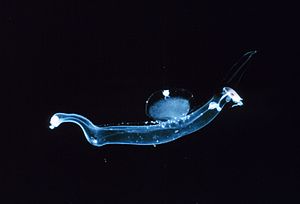Pterotracheidae
| Pterotracheidae | ||||||||||||
|---|---|---|---|---|---|---|---|---|---|---|---|---|

Pelagic snail of the family Pterotracheidae . |
||||||||||||
| Systematics | ||||||||||||
|
||||||||||||
| Scientific name | ||||||||||||
| Pterotracheidae | ||||||||||||
| Rafinesque-Schmaltz , 1814 |
The Pterotracheidae are a family of snails that are adapted to a pelagic way of life. They are somewhat similar to the planktonic arrow worms .
features
The body is soft, gelatinous, transparent and elongated. In the front there is a mobile trunk and the eyes, the foot is transformed into a swimming fin, the organs are located in the back in a small area called the visceral nucleus . There are also the gonads and the gills. The opaque visceral nucleus is camouflaged by phosphorescent light. The housing is completely rebuilt. The animals swim on their backs with the help of the flipper foot.
nutrition
The Pterotracheidae predatory feed on small fish, salps , jellyfish , arrow worms and other planktonic molluscs. You yourself are eaten by fish and sea turtles .
Occurrence
Their habitat are the warm seas worldwide, including the Mediterranean , where they inhabit the upper 200 meters of the water column in large shoals.
Systematics
Two genera are placed in the family:
- Pterotrachea Forskål, 1775
- Firoloida Lesueur, 1817
In the past, other genera (e.g. Carinaria ) were often placed in the family, but these are now placed in separate families within the superfamily Pterotracheoidea.
literature
- Philippe Bouchet, Jean-Pierre Rocroi: Part 2. Working classification of the Gastropoda. In: Malacologia. 47: 239-283, Ann Arbor 2005, ISSN 0076-2997 , archive.org , ConchBooks, ISBN 978-3-925919-72-5 .
- Victor Millard (Ed.): Classification of the Mollusca. A Classification of World Wide Mollusca. Rhine Road, South Africa 1997, ISBN 0-620-21261-6 , online (PDF; 2.46 MB), at olivirv.myspecies.info, accessed February 25, 2017.
- Winston Ponder & David Lindberg : Towards a phylogeny of gastropod molluscs; an analysis using morphological characters. In: Zoological Journal of the Linnean Society. 119: 83-265, London 1997, ISSN 0024-4082 , doi: 10.1111 / j.1096-3642.1997.tb00137.x